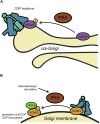Directing Traffic: Regulation of COPI Transport by Post-translational Modifications
- PMID: 31572722
- PMCID: PMC6749011
- DOI: 10.3389/fcell.2019.00190
Directing Traffic: Regulation of COPI Transport by Post-translational Modifications
Abstract
The coat protein complex I (COPI) is an essential, highly conserved pathway that traffics proteins and lipids between the endoplasmic reticulum (ER) and the Golgi. Many aspects of the COPI machinery are well understood at the structural, biochemical and genetic levels. However, we know much less about how cells dynamically modulate COPI trafficking in response to changing signals, metabolic state, stress or other stimuli. Recently, post-translational modifications (PTMs) have emerged as one common theme in the regulation of the COPI pathway. Here, we review a range of modifications and mechanisms that govern COPI activity in interphase cells and suggest potential future directions to address as-yet unanswered questions.
Keywords: COPI vesicle trafficking; coatomer; glycosylation; interphase; myristoylation; phosphorylation; post-translational modifications; ubiquitination.
Copyright © 2019 Luo and Boyce.
Figures





Similar articles
-
In tobacco leaf epidermal cells, the integrity of protein export from the endoplasmic reticulum and of ER export sites depends on active COPI machinery.Plant J. 2006 Apr;46(1):95-110. doi: 10.1111/j.1365-313X.2006.02675.x. Plant J. 2006. PMID: 16553898
-
COPI in ER/Golgi and intra-Golgi transport: do yeast COPI mutants point the way?Biochim Biophys Acta. 1998 Aug 14;1404(1-2):33-51. doi: 10.1016/s0167-4889(98)00045-7. Biochim Biophys Acta. 1998. PMID: 9714721 Review.
-
Sequential coupling between COPII and COPI vesicle coats in endoplasmic reticulum to Golgi transport.J Cell Biol. 1995 Nov;131(4):875-93. doi: 10.1083/jcb.131.4.875. J Cell Biol. 1995. PMID: 7490291 Free PMC article.
-
Formation of COPI-coated vesicles at a glance.J Cell Sci. 2018 Mar 13;131(5):jcs209890. doi: 10.1242/jcs.209890. J Cell Sci. 2018. PMID: 29535154 Review.
-
Proteomic Profiling of Mammalian COPII and COPI Vesicles.Cell Rep. 2019 Jan 2;26(1):250-265.e5. doi: 10.1016/j.celrep.2018.12.041. Cell Rep. 2019. PMID: 30605680
Cited by
-
COPI vesicle formation and N-myristoylation are targetable vulnerabilities of senescent cells.Nat Cell Biol. 2023 Dec;25(12):1804-1820. doi: 10.1038/s41556-023-01287-6. Epub 2023 Nov 27. Nat Cell Biol. 2023. PMID: 38012402 Free PMC article.
-
A paralog-specific role of COPI vesicles in the neuronal differentiation of mouse pluripotent cells.Life Sci Alliance. 2020 Jul 14;3(9):e202000714. doi: 10.26508/lsa.202000714. Print 2020 Sep. Life Sci Alliance. 2020. PMID: 32665377 Free PMC article.
-
Acute COG complex inactivation unveiled its immediate impact on Golgi and illuminated the nature of intra-Golgi recycling vesicles.Traffic. 2023 Feb;24(2):52-75. doi: 10.1111/tra.12876. Epub 2022 Dec 15. Traffic. 2023. PMID: 36468177 Free PMC article.
-
Identification of mosquito proteins that differentially interact with alphavirus nonstructural protein 3, a determinant of vector specificity.PLoS Negl Trop Dis. 2023 Jan 25;17(1):e0011028. doi: 10.1371/journal.pntd.0011028. eCollection 2023 Jan. PLoS Negl Trop Dis. 2023. PMID: 36696390 Free PMC article.
-
Mapping PP1c and Its Inhibitor 2 Interactomes Reveals Conserved and Specific Networks in Asexual and Sexual Stages of Plasmodium.Int J Mol Sci. 2022 Jan 19;23(3):1069. doi: 10.3390/ijms23031069. Int J Mol Sci. 2022. PMID: 35162991 Free PMC article.
References
Publication types
Grants and funding
LinkOut - more resources
Full Text Sources
Miscellaneous

